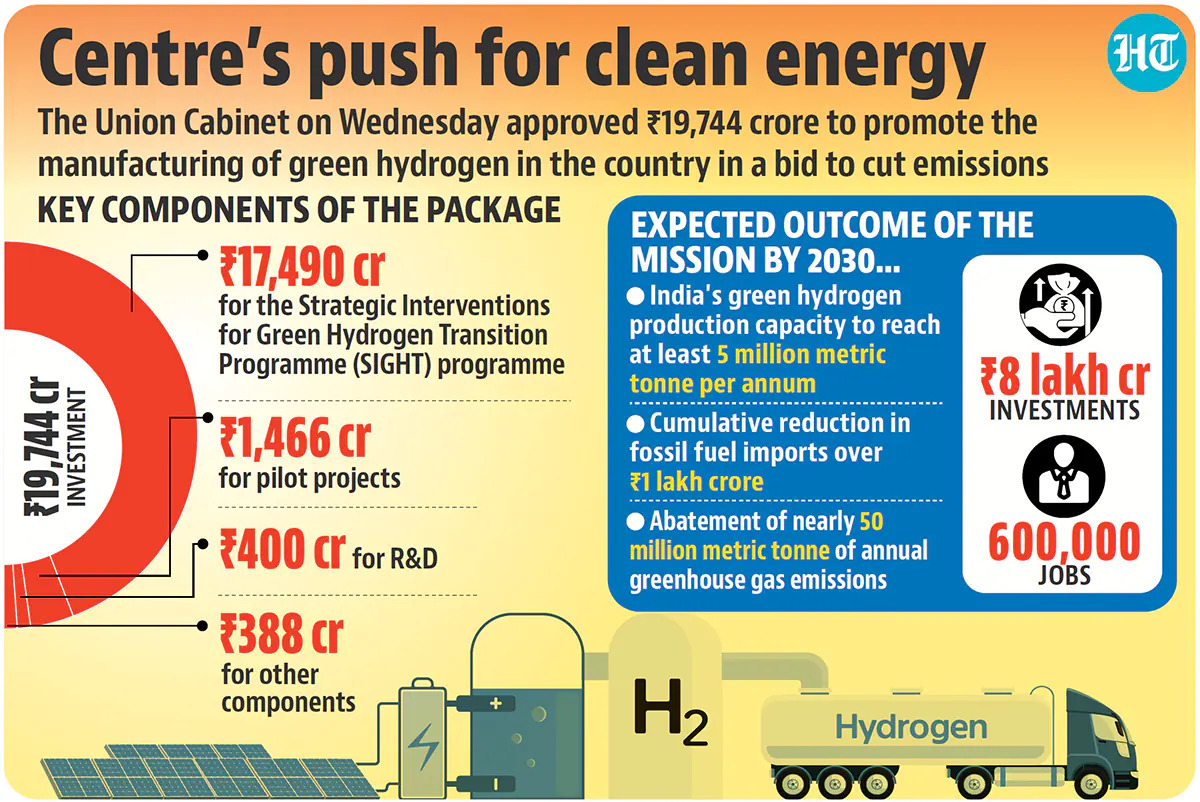Banking on Hydrogen
January 7, 2023 | Expert Insights

India is attempting to switch from fossil fuels to renewable energy sources, and the National Green Hydrogen Mission (NGHM)is a crucial part of that effort. Green Hydrogen is believed to be important in halting climate change in the upcoming years.
With a mission outlay of Rs. 19,744 crores, NGHM was approved by the Union Cabinet recently. The Mission's goals are to make India energy independent, develop domestic manufacturing capabilities, decarbonise the energy sector and use green Hydrogen and its derivatives in mobility applications to lessen reliance on imported fossil fuels and create export opportunities for these products. It is planned to offer incentives to boost the production of affordable green Hydrogen.
Background
Using an electrolyser fuelled by renewable energy, green Hydrogen is created by electrolysing water and splitting it. Green Hydrogen has certain benefits. It can decarbonise industries like iron and steel, chemicals, and transportation because it is a clean-burning molecule. Two, it can be produced using renewable energy that cannot be stored or utilised by the grid.
At the moment, green Hydrogen is not economically viable; the current price of about Rs 350–400 per kilogramme in India. It is unlikely to become profitable until production costs fall below Rs 100 per kilogramme. The NGHM seeks to achieve this.
Following COP 26 in Glasgow, the Indian Government revealed its new nationally decided commitments. By 2030, the Government promised to achieve a 45 per cent reduction in GDP's emissions intensity (from its level in 2005) and a cumulative installed capacity of non-fossil fuel-based energy sources of around 50 per cent. The ultimate goal is to use Hydrogen to fuel critical economic sectors.
The scheme aims to encourage the development of a green hydrogen production capacity of at least 5 million metric tonnes (MMT) per year by 2030, with an associated renewable energy capacity addition of approximately 125 gigatonnes (GW). The Ministry of New and Renewable Energy is developing guidelines for the scheme.
A vital component of this is the Strategic Interventions for Green Hydrogen Transition Programme (SIGHT), which calls for the promotion of two financial incentive mechanisms aimed at domestic electrolyser manufacturing and green hydrogen production to reduce fossil fuel imports and annual greenhouse gas emissions by 2030.
The steel industry has been included as a stakeholder in the proposed Mission, and it has been suggested to establish pilot plants with partial government funding to investigate the viability of using green Hydrogen in Direct Reduced Iron (DRI) production by partially substituting Hydrogen for natural gas in gas-based DRI plants. The gas-based DRI units should be encouraged to use the process widely based on the results of the pilot projects.

Analysis
The Indian Government has made a brave move, but more work still needs to be done. It can draw ideas from South Africa's Hydrogen Strategy, which is aimed at helping that country become a significant producer and exporter of green Hydrogen. South Africa has several advantages regarding Hydrogen, including knowledge of the Fischer-Tropsch process, a wealth of renewable energy sources, and a sizable capability for producing platinum group metals (PGM), a crucial component for hydrogen applications.
The viability of green Hydrogen, an expensive technology, can be increased with government backing. The practicality of such projects will increase with the funding of pilot projects and strategic interventions, particularly if electrolysers are the emphasis. This will also encourage greater private-sector investment.
But experts warn that there are caveats; any green strategy must be energy efficient which Hydrogen products are not at this juncture. The next issue is the ability to use the energy produced from a renewable source as a direct source of power and not convert it to another source, such as Hydrogen; each conversion consumes more energy rendering the entire process inefficient. More importantly, green energy must be produced close to the places where it is to be consumed; transportation will again add to its costs. Environmentalists warn that green energy like Hydrogen will not be genuinely green until it is produced entirely from renewables such as wind farms, solar banks etc.
Assessment
- Green Hydrogen will play a significant role in the transportation sector's energy transition, especially in long-distance travel, where electric vehicles are now impractical due to the size of their batteries and the required infrastructure.
- Green Hydrogen is only a link in the energy transition chain. We must first accelerate the deployment of renewable electricity to decarbonise existing power systems before finally decarbonising sectors like heavy industry, shipping and aviation that are hard to decarbonise through green Hydrogen.








Comments